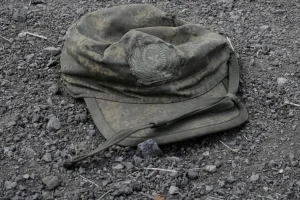
Iran sends Russia weapons across Caspian Sea, West can do little to stop it – CNN
Iran ships ammunition across Caspian Sea to help Russia wage its war on Ukraine as the US and allies are trying to disrupt the military cooperation between Moscow and Tehran
The route across the Caspian Sea – which provides a direct path between Iran and Russia – is increasingly busy with cargo traffic, including suspected weapons transfers from Tehran to Moscow, CNN reports on Friday, May 26.
According to experts, the Caspian Sea route is being used for shipping drones, ammunition, and mortar shells that the Russian government has purchased from the Iranian regime to reinforce its war effort in Ukraine. According to tracking data, vessels in the region are increasingly going "dark," implying a rising effort to hide the flow of cargo.
Last year, Lloyd's List Intelligence data revealed a September surge in the amount of gaps in Caspian vessel tracking data. This comes shortly after the US and Ukrainian governments said Moscow purchased drones from Tehran last summer. In the fall, Russia intensified its use of Iranian drones, particularly targeting important energy facilities in Ukraine.
Analysts say that Ukraine’s Western allies would have little power to stop such arms deliveries.
“There is no risk to Iranian exports in the Caspian Sea because of the bordering countries – they don’t have the capability or motive to interdict in these sorts of exchanges,” said Martin Kelly, lead intelligence analyst at security company EOS Risk Group. It’s a “perfect environment for this trade to go unopposed,” Kelly added.
According to Kelly, there has been a general increase in the number of vessels in the Caspian Sea turning off their tracking data between August and September of 2022. According to Lloyd's List Intelligence data, the number of gaps in ship monitoring data remained high in 2023.
According to an International Maritime Organization regulation, most vessels must carry a tracking device that automatically transmits location and identifying data to other ships and coastal authorities. With few exceptions, those automatic identification systems (AIS) are meant to transmit data at all times for safety reasons. However, ships can disable their AIS tracking, which can be used to conceal parts of their route, mask destinations, or go "dark" when calling into a port.
Most gaps in the tracking data have occurred near Iran’s Amirabad and Anzali ports, as well as in Russia’s port in Astrakhan.
Several trends emerged: some of the ships may be spotted sailing from Iranian ports to Astrakhan, while not making an official port call there. Other suspect vessels can be seen going dark on their approach to Iran's Amirabad Port and Russia's Astrakhan Port, or shutting off their monitoring data for extended periods of time.
Despite the fact that researchers believe it's difficult to know what cargo is on these ships without eyewitness testimony or satellite imagery, the patterns in suspected nefarious activity in the Caspian Sea support Western intelligence claims of Iran's drone exports to Russia.
“There’s a correlation between Russia requesting drones from Iran, dark port calls in the Caspian Sea, and an increase in dark AIS activity,” Kelly said.
Weapons delivered by air
Ukraine, Western nations, and security specialists have also accused Iran of flying weapons and supplies to Russia.
According to a March 2022 statement from the National Resistance Center of Ukraine, three Iranian state-owned aircraft and "one supposedly private one" called Mahan Air transported drones "and instructors" to Moscow.
The US Commerce Department identified four Iranian cargo planes that went to Russia in violation of American export rules last year, with US authorities attributing those flights to "backfilling items to Russia."
CNN examined Flightradar24 tracking data for those four cargo flights, which revealed that the Iranian jets made at least 85 trips to Moscow airports between May 2022 and March 2023.
“There are some Iranian state airlines that are transporting drones from Iran into Russia,” Kelly of EOS Risk Group said. “However, in terms of the comparison of the volume of what can be transported in a single voyage, a ship gives you a much larger volume and capability.”
Military cooperation between Russia and Iran continues in 2023
Analysts expect levels of nefarious activity and “dark” port calls in the Caspian Sea to remain high in 2023, and that Moscow’s sway over the world’s largest inland body of water will go unchecked.
“They don’t have any other authority there to hide from,” said Bosphorus Observer analyst Yörük Işık of vessels navigating the Caspian Sea.
He also noted that a “Russian-flagged ship gives you an extra layer of protection,” given other nations and actors in the region are fearful of questioning or interfering with Russian vessels.
“The Caspian Sea used to be a theater of confrontation between Russia and Iran, and now it’s a potential avenue for sanction evasion and potential weapon provision,” said Aniseh Bassiri Tabrizi, head of the Middle East and North Africa program at the Royal United Services Institute (RUSI), noting that the countries have a more equal partnership now, especially when it comes to military cooperation.
-
The Russians were expecting a new batch of Iranian kamikaze drones, and this explains the recent lull. Now Russia is ready to launch new attacks
-
Iran helps Russia wage an aggressive war in Ukraine and delivers ammunition by water across the Caspian Sea to Astrakhan
-
Russia has exported 200 containers with Iranian weapons by 2 cargo ships, which contained 100 million rounds of ammunition and 300,000 shells
-
On May 17, Russia and Iran signed an agreement to build a railway corridor that will compete with the Suez Canal as a major global trade route
- News













































